

September 2024 NewsletterISSN: 1933-8651
In this issue we present the following articles, news, announcements, and reviews:
|
Articles, Essays, and Reports
News and Announcements
Conferences and Calls for Papers
New Books
Book Reviews
|
Planning the Future of Alexandria's
Freedom House Museum at 1315 Duke Street
By Tatiana Niculescu
Alexandria Archaeology
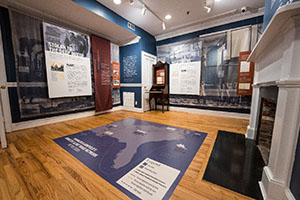
Alexandria's Freedom House Museum at 1315 Duke Street has now been under City of Alexandria operation for over two years. Thousands of people from around the United States and the world have visited this powerful site. The building that houses the museum represents what remains of a large complex through which thousands of Black men, women, and children were trafficked between 1828 and 1861. In the decades before the Civil War, Alexandria was a major port in the domestic trade of enslaved people and a variety of firms operated within the city, forcibly transporting people from the Chesapeake region to the Deep South. At its height, the massive complex spanned nearly half a city block, enclosed by high brick walls and fencing. The museum seeks to reframe white supremacist history that erased and diminished the contributions of African Americans to the national narrative. This museum honors the lives and experiences of the enslaved and free Black people who lived in and were trafficked through Alexandria.
Since the museum's opening with temporary exhibitions, the Office of Historic Alexandria has also initiated a comprehensive planning process to determine the future use, interpretation, and preservation of this important site. This process requires the expert assistance of several project partners who consult on everything from the structural soundness of the building to exhibit design and interpretation strategies. Perhaps even more critically it requires the input of the community and other stakeholders. Over 400 people responded to a survey about the museum, sharing their vision for the museum's future. Between March and June 2023, the City of Alexandria conducted a series of meetings to begin a conversation about the site's mission, a new potential name, the interpretive focus, and the museum's role in the community. Participants included community representatives, educators, and students. The group pondered a number of questions including what stories have been buried, what is unique or special about this site, whose voice should narrate the story, and what activities they would like to see in this museum. They were also polled on their experiences within the existing museum space, what features helped them learn or evoked strong emotions, and what other African American heritage sites should be connected to the interpretation of this museum. Full summaries of these meetings can be found online.
[Read or download this full article in Adobe format >>>].
[Return to table of contents]
Profiles in Practice: Jodi Skipper
By Christopher C. Fennell

This newsletter feature on "profiles in practice" provides brief overviews of the recent activities of researchers and activists in African diaspora subjects. Please contact Chris Fennell (cfennell@illinois.edu) if you would like to contribute a profile for a future newsletter issue.
Dr. Jodi Skipper is a Professor in the Department of Sociology and Anthropology and the Center for the Study of Southern Culture at the University of Mississippi. She has a national reputation within our field for her advocacy of Black feminist and critical race perspectives for exploring ways of addressing structural racism in our society today. She has received numerous recognitions for her excellence in teaching, mentorship, and service. Dr. Skipper's accomplishments are evident in a long list of awards and recognitions, including a Whiting Foundation Humanities Public Engagement Fellowship, a Mississippi Humanities Council Scholar Award, and the University of Mississippi's Excellence in Community Engagement Award.
Dr. Skipper's collaborations in the "Behind the Big House" and "Grace the Table" initiatives have been remarkably productive. Her early steps in this project were supported by prestigious organizations such as the Gilder Lehrman Institute of American History at Yale University. Dr. Skipper's outreach efforts have also been active at a broad scale, including the National Humanities Alliance meetings in Washington, DC. In a more recent and expanded scale of such engagements, she is working with the International Coalition of Sites of Conscience to develop ways of using heritage tourism at sites of slavery to address structural racism in today's society. She also serves as a member of the Coalition's North American Regional Steering Committee.
Dr. Skipper served as lead author in the article "The Big House as Home," which she co-authored with her graduate student, Suzanne Davidson, in the International Journal of Tourism Anthropology (2018). Such co-authorship collaboration with graduate students is highly valuable as an important way to help advance a young scholar early in their career. This is a fascinating article which addresses questions which many find challenging in the course of their own research: how can "historic site interpretations" serve to "facilitate reconciliatory relationships between descendants of enslaved populations and descendants of their enslavers"? Dr. Skipper extends her analysis further, employing her perspectives from critical race studies, to ask how African Americans can come to view sites of slavery as "ancestral homesteads" and not just terrains of a painful past. She relates her research and findings at sites in Mississippi to broader comparisons with research on slavery sites in West Africa and South America. She builds from her research findings to provide take-away lessons of strategies for successful, public applications. Dr. Skipper and her co-author lay out tangible steps that historic sites can take to move from "civic alienation" to "civic belonging." The article also provides fascinating observations consistent with phenomenological analysis of the ways in which individuals have "embodied experiences" in engaging with sites of slavery, and how those sites can come to represent metonymic connections with a past which those individuals previously avoided. Such analysis enlivens pathways for reconciliation.
Dr. Skipper takes a different analytic approach to the data from the Behind the Big House initiative in a book chapter, "Hidden in Plain Sight: Contested Histories and Urban Slavery in Mississippi" (2021). This chapter was published in an edited volume entitled
Challenging History: Race, Equity, and the Practice of Public History (University of South Carolina Press). The book resulted from a conference organized in 2017 after the racist murders of several congregants at the Mother Emanuel African Methodist Episcopal Church in Charleston. Dr. Skipper's study, along with other chapters in the book, work to challenge racial ideologies in the United States by confronting and dispelling myths, distorted perceptions, and historical erasures. Her study presents an analysis of the ways in which the dynamics of urban slavery have been under-examined in historical research. Dr. Skipper shows how public outreach efforts to convey accurate accounts of past, urban slavery can enhance civic consciousness among Americans.
She further translated research findings from the Behind the Big House and Grace the Table initiatives into ways of improving African-American students' engagements with public history at her university. These transformations from analysis to tangible steps in pedagogy are detailed in her co-authored book chapter "Public History, Diversity, and Higher Education" (2017). That chapter was published in a volume co-edited by Dr. Skipper (with Michele Coffey) entitled Navigating Souths: Transdisciplinary Explorations of a U.S. Region (University Press of Georgia). This book presents 14 studies of the ways in which theoretical frameworks have been applied to analysis of a variety of southern sites and steps for enhancing fields such as public history. Dr. Skipper's "Introduction" chapter (with Michele Coffey) similarly details an insightful analytic framework for fostering interdisciplinary and comparative work in Southern studies across social, political, cultural, historical, and pedagogical perspectives. She promotes initiatives that move through rigorous research projects, collaborations, civic engagement, and applications for societal improvement and advocacy.
Dr. Skipper's insights through a Black feminist perspective are also evident in her co-authored article "Remembering Ida" in the peer-reviewed Southern Culture (2020) journal. This study presents a vitally important insight from critical race studies, and advocates that we not view Ida B. Wells-Barnett and an exceptional character or a "sui generis" phenomenon within Black political culture. Skipper and her co-authors place Wells-Barnett's intellectual, ideological, and political development in the social and historical contexts of her early years in Mississippi. They emphasize the many ways in which Wells-Barnett's extraordinary accomplishments were in fact representative of comparable commitments among many African Americans as they combated overt and structural racism in the nineteenth century.
I recently launched a new book series with Routledge Press on "Restorative Justice in Heritage Studies and Archaeology" with my colleagues Nedra Lee (U. Massachusetts, Boston) and Richard Benjamin (University of Liverpool). Dr. Skipper's 2022 Behind the Big House book is the type of excellent blend of rigorous research and take-away lessons for advocacy that we hope to recruit for this series. It is no wonder that she received the prestigious Nelson Graburn Book Prize for this volume from the American Anthropological Association in 2022. Her incisive analysis combines insights from a Black feminist approaches, critical race studies, and critical heritage research to examine the ways in which sites of past enslavement can be examined to reveal erased histories and advance anti-racist initiatives to improve society today. In doing so, Dr. Skipper provides discussions of the intersecting subjects of modes of restorative justice and reconciliation, particularly as employed in public history projects and heritage tourism sites. She has also composed the book with a highly engaging, multi-vocal approach. This is an essential facet of scholarship in restorative justice.
[Return to table of contents]
Archaeology of Racial Violence:
An Update of the Springfield Race Riot Project
By Floyd Mansberger and Christopher Stratton
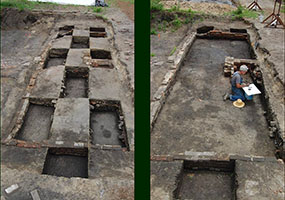
On the morning of August 14, 1908, Mabel Hallam accused George Richardson of having raped her the night before. Although Mrs. Hallam was later to recant her story, absolving Mr. Richardson of any wrong-doing, her actions unleashed a fury of violent activity that was to wreck havoc with the City of Springfield. On August 14 the City of Springfield erupted in racially motivated mob violence that lasted for several days, and resulted in the lynching of two African-American citizens, as well as the destruction of numerous houses and businesses within the city. Much of the violence was centered on the Levee commercial district and residential Badlands. The violence was subdued through the efforts of the Illinois National Guard.
The Springfield Race Riot of 1908 was one of the catalysts that resulted in the formation of the National Association for the Advancement of Colored People (NAACP). On February 12, 1909 (in conjunction with the 100th anniversary of Lincoln's birth), the organization was formed. As quoted in the NAACP's webpage, "The NAACP was formed partly in response to the continuing horrific practice of lynching and the 1908 race riot in Springfield, the capital of Illinois and resting place of President Abraham Lincoln."
Phase II archaeological investigations on the Carpenter Street Underpass Project (the first component of the Springfield Rail Improvements Project) was undertaken in 2014. Over 40 houses and business were destroyed in the Badlands during the August 14-15, 1908 weekend in Springfield. The well preserved remains of five houses constructed in the 1840s were uncovered during these investigations. They were built on lots re-oriented to face Tenth Street, along which the Great Western Railroad ran through Springfield. The homes initially were occupied by white families. By the late 19th century the residences were predominately occupied by African Americans.
This study overview by Floyd Mansberger and Christopher Stratton was presented to the Chicago Archaeological Society in March 2024. On August 16, 2024 President Biden designated the site of the 1908 race riots as a National Monument.
[Read or download this full presentation in Adobe format >>>].
[Return to table of contents]
Recent Dissertations on Archaeology, Biology, and History

The following, non-exhaustive list of dissertations and masters theses on African diaspora archaeology and history for the period of September 2023 to September 2024 was compiled by Chris Fennell based on listings in the Proquest.com service. The September 2005, 2006, 2007, 2008, 2009, and 2010 issues of the African Diaspora Archaeology Newsletter provided similar compilations of dissertations and theses on archaeology and history for the period of 2000-2010. The September 2022 issue provides a compilation of dissertations and theses in archaeology for 2010-2022. The December 2022 issue provides a compilation of dissertations and theses in history for 2010-2022, followed by an annual listing in September 2023. If you are aware of other recent dissertations, please email me, and I will include the information in a future newsletter edition. The studies listed below are doctoral dissertations (PhD) or master's theses (MA or MS), and are listed in chronological order by year and then alphabetic order by the author name within each year. Abstracts and full texts are available online from the Proquest.com service.
Archaeology and Biological Anthropology
"A Historic Place of Peace and Reflection": A Critical Analysis of Digital Methods in the Recovery of Forgotten Black Cemeteries, by Sofia M. Almeida, MA, University of South Florida, 2024.
Echoes of Freedom and Resistance: A Mixed Methods Study of Intersectional Heritage and Florida Marronage at Prospect Bluff, by Bria Rhontise Brooks, MA, University of West Florida, 2024.
The Nathan Harrison Historical Archaeology Project: Building a California K-12 Curriculum, by Caeli Elizabeth Gibbs, MA, San Diego State University, 2024.
Enslavement at Fort Snelling: Challenging Colonialism at One of Minnesota's Most Celebrated Historic Sites, by Sophie Minor, PhD, University of Minnesota, 2024.
Recipes for Resistance: Examining the Reproduction of Indigeneity Through Foodways at the Seneca Boston-Florence Higginbotham House, Nantucket, MA, by Caitriona M. Parker, MA, University of Massachusetts Boston, 2024.
A Home for All: Innovative Management and Research Methodologies for Historic Archaeologists at Federally Regulated Landscapes at the Garnet Ghost Town, Andrea Jean Shiverdecker, PhD, University of Montana, 2024.
And the Gates of Hell Shall Not Prevail: Community Archaeology and Reconnaissance of the St. James African Methodist Episcopal Zion Church in Ithaca, New York, MyKayla Williamson, MA, Cornell University, 2024.
Recipe for an Identity: Reclaiming an African Identity Through Southern Foodways, by Teresa Dawn Beckelheimer, MA, University of Texas at San Antonio, 2023.
"Go Ahead and Erect the Buildings Themselves:" An Archaeological Study of Three Black Schools in Gloucester County, Virginia, by Colleen Marie Betti, PhD, University of North Carolina at Chapel Hill, 2023.
Reframing Diaspora: Southeastern African Contributions to Biosocial Variation in Atlantic Afro-Descendant Groups, by Andreana Cunningham, PhD, University of Florida, 2023.
An Interdisciplinary Approach to the Social Landscape of a Jamaican Sugar Estate, 1754-1828, by Sean Devlin, PhD, University of Minnesota, 2023.
Sisters and Stewards: Women and Community-Building at the African Meeting House on Nantucket, MA, by Sean A. Fairweather, MA, University of Massachusetts Boston, 2023.
Sartorial Practices and Daily Life: Examining Black Womanhood in Nineteenth-Century Boston, by Erica A. Lang, MA, University of Massachusetts Boston, 2023.
A Black Mount Vernon: Exploring Enslaved Homespace and Family at Mount Vernon Plantation, by Heather Little, MA, College of William and Mary, 2023.
Equity for the Ancestors: African American Cemeteries in Southern Urban Spaces and the National Register of Historic Places, by Steph McDougal, PhD, Middle Tennessee State University, 2023.
The Virginia Peasantry: A Study of Farms in Stafford and Caroline Counties, the Eighteenth Through the Twentieth Century, by Catherine Roberts, PhD, University of Maryland, College Park, 2023.
Navigating Power: An Archaeological Examination of Movement on Lowcountry Waterways, by Emily Anne Schwalbe, PhD, Northwestern University, 2023.
History
Sacred and Secular: African American Women's Expressions Through Folk Music, 1933-1950, by Le'Evelyn K. Hammett, MA, Morgan State University, 2024.
Harriet Tubman: A Narrative of African Agency From Enslavement to the National Association for Colored Women, by Carmella Harris, PhD, Temple University, 2024.
A Colorblind Approach to Silencing African American Voices Through the Banning of Critical Race Theory, by Mia J. Freeman, MA, University of Alabama at Birmingham, 2023.
Africans in Louisiana: An Afrocentric Analysis of Southwest Louisiana's Culture Through the Lens of Spirituality, by Lindsay Gary, PhD, Temple University, 2023.
Black Racial Isolation: Understanding African Diaspora Subjectivity in Post-Racial Denmark, by Elizabeth Löwe Hunter, PhD, University of California, Berkeley, 2023.
"Mingled Together": Irish and African American Relations in Civil War-Era Philadelphia and Baltimore, by Michael F. Johnson, PhD, George Washington University, 2023.
Black American Culture and the Digital Landscape: Modern Heritage Challenges in the 21st Century, By Michael TréShawn Randall, MA, Rutgers The State University of New Jersey, 2023.
Afro-Modernism: How Black Art Movements Transmitted Their Message through Afrocentricity, by Aujonee Smith, MA, State University of New York at Buffalo, 2023.
[Return to table of contents]
Journal of African Diaspora Archaeology and Heritage Updates
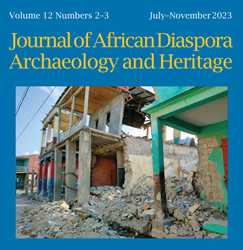 Please consider submitting an article to our peer-reviewed journal. We hope you find some of our recent articles of interest:
Please consider submitting an article to our peer-reviewed journal. We hope you find some of our recent articles of interest:
"Valongo, the Place of the Ancestors: Spiritual Practices among Enslaved Africans in Nineteenth-century Rio de Janeiro," by Tania Andrade Lima (open access)
https://doi.org/10.1080/21619441.2024.2393525
"Medicine, Reproduction, and Women's Health at the Orange Valley Plantation, Jamaica," by Jacqueline Woodruff, Richard Veit, and Nicola Kelly
https://doi.org/10.1080/21619441.2024.2347082
"Renegotiating and Theorizing Heritage in the Context of 'Disaster' in the Caribbean: The Entanglement of Haitian Disaster-Related Histories," by Joseph Sony Jean and Jerry Michel (open access)
https://doi.org/10.1080/21619441.2023.2301153
"Transformation and Resistance: African Diaspora Archaeology in Brazil," by Lucio Menezes Ferreira and Luis Symanski
https://doi.org/10.1080/21619441.2022.2159377
"African Presence in Portugal: People and Things Within Material, Social, and Power Relations," by Tânia Manuel Casimiro, Francisco Curate, and Nathalie Antunes-Ferreira
https://doi.org/10.1080/21619441.2023.2290811
"Excavating Enslavement in the Garden State: Historical Archaeology of an Eighteenth and Nineteenth Century Plantation Near Trenton, New Jersey," by Nicholas Wekselblatt and George M. Leader
https://doi.org/10.1080/21619441.2023.2182345
[Return to table of contents]
Toyin Falola Inaugurates New Field of African Ancestral Studies
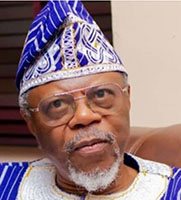 By Israel Olaniyonu
By Israel Olaniyonu
September 15, 2024
Nigerian Tribune.
On October 15, 2024, at the University of Ghana, Professor Toyin Falola, Africa's most decorated humanities scholar, will inaugurate a new field, African Ancestral Studies (AAS). The inauguration is part of the preface to the 2024 Anton Wilhelm Lecture, organized annually by the Merian Institute for Advanced Studies in Africa, one of the high-profile events at the University of Ghana.
The idea of this new field has generated widespread enthusiasm as he explains its foundational platform and multi-layered contents.To those who want to teach the subject, Falola has made available close to a dozen syllabi.In a series of interviews with journalists across Africa, he explains that the field will cumulate themes and topics from a dozen fields into what is deeply African, thus adding to the promotion of the idea of African universities instead of universities in Africa. AAS will merge ideas on what we traditionally call heritage, culture, and identity.
Falola is set to announce the various dimensions of African Ancestral Studies in greater detail, focusing on the following areas: Genealogy and Ancestral Lineage, Cultural Practices and Traditions, Governance, Kingship and Political Institutions, Spiritual and Religious Beliefs, Historical Studies, Diaspora and Identity, Language and Oral Traditions, Arts and Material Culture, Intersections with African Philosophy, African Ancestral Studies and Modernity, Indigenous Knowledges, Ancestral Studies and Popular Culture, and the Role of African Ancestral Studies on Global Africa.From tracing ancestral lineage to recovering cultural knowledge and identity, AAS -- as a fluid and interdisciplinary field -- seeks to reconnect people and communities to their past, both on the African continent and in the diaspora.However, it is crucial to distinguish African Ancestral Studies from the study of African history and Heritage Studieswrit large, as it will cover more than one person, more than one generation, spanning time and space, and more than one context.AAS will see both the collective and the personal in the past.
[Read this full article online >>>].
[Return to table of contents]
Interior Department Prepares to Nominate
U.S. Civil Rights Movement Sites for World Heritage List
 Press Release
Press Release
July 16, 2024
U.S. Department of the Interior
Washington, DC -- Secretary of the Interior Deb Haaland today announced that she has authorized the National Park Service to prepare a potential nomination for 11 U.S. Civil Rights Movement sites in Alabama, Arkansas, Georgia, Kansas, Mississippi, Virginia and Washington, DC to be added to the UNESCO World Heritage List.
If designated, the sites would join other cultural and natural sites of universal importance, such as Grand Canyon National Park in Arizona, the Taj Mahal in India, and the Galápagos Islands in Ecuador on the World Heritage List. The Department has also authorized the National Park Service to prepare a possible nomination of the Okefenokee National Wildlife Refuge in Georgia. There are currently 1,199 World Heritage Sites in 168 countries, including 25 in the United States. The National Park Service manages all or part of 19 of the 25 U.S. sites.
“The U.S. sites that mark the civil rights movement are integral in helping us tell a full and complete story of American history,” said Secretary Deb Haaland. “We are honored to be entrusted with the responsibility of preserving these stories as part of our enduring effort to pursue a more perfect union. A nomination of these sites to the World Heritage List would further recognize the pain, redemption and healing associated with these historical sites and honor the civil rights heroes who bravely sat, marched and fought to secure equality for all Americans.”
The following are the 11 U.S. Civil Rights Movement Sites included in the proposed nomination. Nine are managed by the National Park Service:
- Dexter Avenue King Memorial Baptist Church, Montgomery, Alabama
-
Bethel Baptist Church, Birmingham, Alabama (part of Birmingham Civil Rights National Historic Site)
-
16th Street Baptist Church, Birmingham, Alabama (part of Birmingham Civil Rights National Historic Site)
-
Edmund Pettus Bridge, Selma, Alabama (part of Selma to Montgomery National Historic Trail)
-
Greyhound Bus Terminal, Anniston, Alabama (part of Freedom Riders National Monument)
-
Little Rock Central High School, Little Rock, Arkansas (Little Rock Central High School National Historic Site)
-
Ebenezer Baptist Church (Heritage Sanctuary), Atlanta, Georgia (part of the Martin Luther King, Jr. National Historical Park)
-
Monroe Elementary School, Topeka, Kansas (part of Brown v. Board of Education National Historical Park)
-
Medgar and Myrlie Evers Home, Jackson, Mississippi (Medgar and Myrlie Evers Home National Monument)
-
Robert Russa Moton High School/Museum, Farmville, Virginia
-
Lincoln Memorial and Grounds, Washington, District of Columbia (part of National Mall and Memorial Parks)
The Department will collaborate with partners and consult with the Federal Interagency Panel for World Heritage on the completed document before making a final decision on whether to submit the nomination for the Civil Rights Movement Sites to the World Heritage Committee. If submitted, the final decision on inclusion on the list will be made by the World Heritage Committee, composed of representatives from 21 nations elected from the members of the World Heritage Convention, and advised by the International Council on Monuments and Sites.
The National Park Service is the principal government agency responsible for implementing the World Heritage Convention on behalf of the Department and in cooperation with the Department of State. Inclusion of a site in the World Heritage List does not affect management of the sites, which remain subject only to U.S. law. Detailed information on the World Heritage Program and the process for the selection of U.S. sites can be found at https://www.nps.gov/subjects/internationalcooperation/worldheritage.htm.
[Return to table of contents]
Lemon Project Spring 2025 Syposium
March 21-22, 2025, Williamsburg, Virginia
Call for Papers

In 2025, the Lemon Project celebrates fifteen years of our spring symposium. As we navigate today's world, the reparative and healing work of the Lemon Project is as vital as it has ever been. Remembering the past fifteen years of symposium gatherings, we celebrate Black resilience through the theme, "Undefeated: Black Resilience through Resistance, Creativity, and Cooperation." "Undefeated" beckons us to embrace communal strength in a world where obstacles seem insurmountable, and challenges are relentless. The symposium celebrates the indomitable spirit of resilience, the power of cooperation, and the transformative force of creativity within Black communities. This gathering aims to explore how these interconnected themes shape the experiences, challenges, and triumphs of Black individuals and communities worldwide.
The 2025 Spring Symposium will explore the following questions: How have historical experiences of adversity and resilience shaped the current strengths and challenges within Black communities? In what ways do Black communities demonstrate resilience through cultural practices, collective action, and grassroots initiatives? What are examples of successful intra community cooperation initiatives that have strengthened solidarity and mutual support within Black communities? What are examples of innovative solutions and entrepreneurship within Black communities that address local challenges and foster economic resilience. These questions will stimulate meaningful discussions and explore innovative ideas at the symposium focusing on resistance, resilience, cooperation, and creativity within Black communities. We encourage participants to reflect on historical contexts, celebrate cultural strengths, and envision collaborative pathways towards sustainable empowerment and social justice. We also invite you to review past symposium themes and submit a proposal related to a past theme. https://www.wm.edu/sites/lemonproject/annual_symposium/.
[Return to table of contents]
Archaeology in the Community
Call for Interest
in Skills Workshops

Archaeology in the Community (AITC) has launched a new series of virtual continuing education opportunities, called Brush Up Workshops. The focus is on topics in public archaeology such as working with schools and communities, inclusivity, communication, etc. The intended audiences for the trainings are professional archaeologists, educators, and interested community members. The next workshop in the series, “Curb Cut Effect: Addressing Disability and Ableism” on October 16, helps participants think about accessibility in the workplace and how addressing these issues benefits everyone. These and future trainings are designed for anyone who engages in the discovery and stewardship of archaeology and heritage. The Brush Up Workshops are sponsored by the Society of Black Archaeologists (SBA). Registration is half-off for SBA members and free for students in the SBA mentoring program. Revenue from registration fees supports AITC's year-round educational programming for all ages. Brush up on your archaeological skills!
Learn more and register online at https://www.archaeologyincommunity.com/workshops.html.
[Return to table of contents]
Society for Black Archaeologists
Call for Interest
in Regional Writing Groups

In celebration of the 15 year anniversary of the Society of Black Archaeologists in 2026, we are organizing writing groups to celebrate our collective power in knowledge production, while at the same time gathering across different regions to curate the next era of SBA scholarship.
We hope to engage with members from across the writing spectrum reaching students, emerging scholars, advanced career writers, and those new to the writing process in the world of archaeology. This is about building regional hubs to write together and generate something new to mark this milestone in SBA history!
Launching in Fall 2024. Deadline to submit interest form October 15th: https://forms.gle/PNAm81hrx4cL167T6.
Any questions about submitting? Please send a message to presidentelect@societyofblackarchaeologists.com.
[Return to table of contents]
African American Intellectual History Society
Tenth Annual Conference, March 14-15, 2025
Call for Papers
Conference Theme: Slavery and Its Afterlives
Providence, Rhode Island.

In Lose Your Mother: A Journey Along the Atlantic Slave Route (2008), historian and literary scholar Saidiya Hartman describes her personal quest to "reckon with the lives undone and obliterated in the making of human commodities." She continues, "If slavery persists as an issue in the political life of black America, it is not because of an antiquarian obsession with bygone days or the burden of a too-long memory, but because black lives are still imperiled and devalued by a racial calculus and a political arithmetic that were entrenched centuries ago." This, Harman explains, "is the afterlife of slavery -- skewed life chances, limited access to health and education, premature death, incarceration, and impoverishment."
Since the publication of Hartman's groundbreaking memoir, the phrase "afterlife of slavery" has been deployed across humanities fields to underscore the significant connection between periods before and after slavery. For its tenth anniversary annual conference, the African American Intellectual History Society (AAIHS) invites individual and panel proposals that grapple with the history of slavery and its afterlives in the United States and throughout the broader African diaspora. Ongoing social, political, and cultural developments demand continued preservation, dissemination, and engagement with the experiences and ideas of African Americans and others across the African diaspora.
By grappling with the theme of "Slavery and Its Afterlives," AAIHS encourages conference participants to reflect on how histories of African and African-descended peoples from slavery to the present continue to shape and haunt our present and futures in familiar and new ways. We hope this invitation prompts scholars, activists, artists, and other intellectuals to interrogate notions of change, continuity, and progress, all key elements of historical inquiry.
AAIHS welcomes individual and panel proposals for short presentations (12-15 minutes) that consider the conference theme as linked to a variety of perspectives, including, but not limited to, gender, sexuality, public policy, indigeneity, politics, and class. We welcome submissions that explore the conference theme in art and popular culture and in literature. Papers that explore the global historical context and international dimensions of the theme are encouraged. We also invite panels with capacious temporal engagement.
All panel sessions will run for 75 minutes with at least 15 minutes devoted to audience participation. All paper proposals should include a title and an abstract of approximately 300 words. The proposal should clearly explain the paper's argument; methods and methodologies; interventions; and engagement with the conference theme. Submissions should also include a short CV (1-2 pages in length), highlighting previous publications and presentations, if applicable. Full panel proposals should include all the above information for each individual panelist as well as an overall abstract (less than 300 words) articulating the key questions and themes of the papers collectively and how the totality of the papers relate to the conference theme. We strongly encourage experimental formats, workshops, art displays, film screenings, roundtables, musical performances, and any other presentations beyond traditional academic papers and panels.
Proposals will be considered for inclusion in one of the featured conference sessions, which will be held in-person from March 14 to March 15, 2025 at the historic Graduate Hotel near Brown University in Providence, RI. A select number of travel grants are available by application only for graduate students, contingent faculty, independent scholars, and junior scholars. AAIHS invites scholars at various ranks and affiliations (from graduate students to senior faculty and independent scholars) to submit proposals for consideration. The best papers selected from conference proceedings will be considered for inclusion in a special issue of Global Black Thought, the official journal of AAIHS.
Submit your proposal online at https://www.aaihs.org/conference-2025/call-for-papers-aaihs-2025/.
[Return to table of contents]
2025 Conference on Public Archaeology
Call for Papers

The 2025 Conference on Public Archaeology is taking place on August 8-9, 2025 in Washington, DC! Abstract submissions are now open and advanced registration will open in March.
This meeting will be hosted by Archaeology in the Community and is intended to provide a dedicated space for public-minded archaeologists and cultural heritage practitioners to share their experiences and expertise. Over two days, we plan to host a series of workshops, panels, round-tables, and special events geared toward addressing some of the most pressing issues in the discipline, including:
- Diversifying professional and avocational representation
- Public archaeology and the Section 106 process
- Community science and heritage site stewardship
- Climate impacts to tangible and intangible heritage resources
- Harnessing digital advances for outreach and education
- Working in schools and engaging with educators
While the Conference on Public Archaeology will forego the traditional paper format, our hope is that discussion, hands-on participation, flexible formats, and professional networking will foster advances and new directions in the discipline. This is the second Conference on Public Archaeology, with the first held in Pensacola, Florida through the Florida Public Archaeology Network in 2023.
Abstract Submissions: We invite you to submit your abstract for the Conference on Public Archaeology. Abstracts should be concise, with a maximum length of 1,000 characters (approximately 150-200 words). Before submitting, please review the detailed Submission Guidelines (PDF). The deadline for abstract submissions is February 10, 2025. Please note that all participants whose abstracts are accepted will be required to register for the conference between March and July 2025. https://www.fpan.us/projects/2025-conference-on-public-archaeology/.
[Return to table of contents]
New Book
Routledge Handbook of Critical African Heritage Studies
Edited by Ashton Sinamai, John D. Giblin, Shadreck Chirikure, and Ishanlosen Odiaua
Routledge Press
528 pp., ISBN-13 978-0367434021, 2024.
Description from the Publisher:
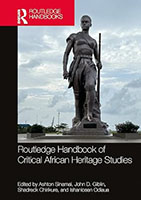 This handbook is a foundational reference point for critical heritage research about Africa and its diaspora. Foregrounding the diversity of knowledge systems needed to examine heritage issues in such a diverse continent, the contributors to this volume: argue for an understanding heritage that is at once both natural and cultural, tangible and intangible, political and dissonant, going beyond the physical and objective to include subjective narratives, performances, rituals, memories and emotions; examine the pre-coloniality, coloniality, post-coloniality, and decoloniality of current African heritage discourses and their consequences; analyse how heritage legislation derived from colonial law is compatible or otherwise with how heritage is perceived, identified and remembered in African communities; discuss questions of repatriation, restitution and reparations in relation to the return of artefacts from Western countries; illuminate the importance of "difficult heritage" within Africa and its diaspora; and consider the role of heritage for development in Africa.
This handbook is a foundational reference point for critical heritage research about Africa and its diaspora. Foregrounding the diversity of knowledge systems needed to examine heritage issues in such a diverse continent, the contributors to this volume: argue for an understanding heritage that is at once both natural and cultural, tangible and intangible, political and dissonant, going beyond the physical and objective to include subjective narratives, performances, rituals, memories and emotions; examine the pre-coloniality, coloniality, post-coloniality, and decoloniality of current African heritage discourses and their consequences; analyse how heritage legislation derived from colonial law is compatible or otherwise with how heritage is perceived, identified and remembered in African communities; discuss questions of repatriation, restitution and reparations in relation to the return of artefacts from Western countries; illuminate the importance of "difficult heritage" within Africa and its diaspora; and consider the role of heritage for development in Africa.
Making a crucial contribution to our understanding of African conceptions and practices of heritage, this book is an important read for scholars of African Studies, heritage and museum studies, archaeology, anthropology and history.
[Return to table of contents]
New Book
Nat Turner, Black Prophet: A Visionary History
By Anthony E. Kaye with Gregory P. Downs
Farrar, Straus and Giroux
352 pp., ISBN-13 978-0809024377, 2024.
Description from the Publisher:
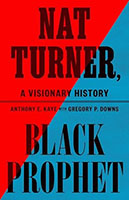 In August 1831, a group of enslaved people in Southampton County, Virginia, rose up to fight for their freedom. They attacked the plantations on which their enslavers lived and attempted to march on the county seat of Jerusalem, from which they planned to launch an uprising across the South. After the rebellion was suppressed, well over a hundred people, Black and white, lay dead or were hanged. As news of the revolt spread, it became apparent that it was the idea of a single man: Nat Turner. An enslaved preacher, he was as enigmatic as he was brilliant. He was also something more -- a prophet, one who claimed to have received visions from the Spirit urging him to act.
In August 1831, a group of enslaved people in Southampton County, Virginia, rose up to fight for their freedom. They attacked the plantations on which their enslavers lived and attempted to march on the county seat of Jerusalem, from which they planned to launch an uprising across the South. After the rebellion was suppressed, well over a hundred people, Black and white, lay dead or were hanged. As news of the revolt spread, it became apparent that it was the idea of a single man: Nat Turner. An enslaved preacher, he was as enigmatic as he was brilliant. He was also something more -- a prophet, one who claimed to have received visions from the Spirit urging him to act.
Nat Turner, Black Prophet is the fullest recounting to date of Turner's uprising, and the first that refuses to tame or overlook his divine visions. Instead, it takes those visions seriously, tracing their emergence from the world of nineteenth-century Methodism, with its revivals, camp meetings, interracial churches, and Black preachers. The rebellion and its aftermath would hasten the end of this world, as Southern states further restricted the personal freedoms of the enslaved, even as the ongoing threat of revolt shaped the country's politics. With this work of narrative history, the late historian Anthony E. Kaye and his collaborator Gregory P. Downs have given us a new understanding of one of the nineteenth century's most decisive events.
[Return to table of contents]
New Book
Night Flyer: Harriet Tubman and the Faith Dreams of a Free People
By Tiya Miles
Penguin Press
336 pp., ISBN-13 978-0593491164, 2024.
Description from the Publisher:
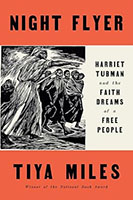 Harriet Tubman is among the most famous Americans ever born and soon to be the face of the twenty-dollar bill. Yet often she's a figure more out of myth than history, almost a comic-book superhero. Despite being barely five feet tall, unable to read, and suffering from a brain injury, she managed to escape from her own enslavement, return again and again to lead others north to freedom without loss of life, speak out powerfully against slavery, and then become the first American woman in history to lead a military raid, freeing some seven hundred people. You could almost say she's America's Robin Hood, a miraculous vision, often rightly celebrated but seldom understood.
Harriet Tubman is among the most famous Americans ever born and soon to be the face of the twenty-dollar bill. Yet often she's a figure more out of myth than history, almost a comic-book superhero. Despite being barely five feet tall, unable to read, and suffering from a brain injury, she managed to escape from her own enslavement, return again and again to lead others north to freedom without loss of life, speak out powerfully against slavery, and then become the first American woman in history to lead a military raid, freeing some seven hundred people. You could almost say she's America's Robin Hood, a miraculous vision, often rightly celebrated but seldom understood.
Tiya Miles's extraordinary Night Flyer changes all that. With her characteristic tenderness and imaginative genius, Miles explores beyond the stock historical grid to weave Tubman's life into the fabric of her world. She probes the ecological reality of Tubman's surroundings and examines her kinship with other enslaved women who similarly passed through a spiritual wilderness and recorded those travels in profound and moving memoirs. What emerges, uncannily, is a human being whose mysticism becomes more palpable the more we understand it -- a story that offers us powerful inspiration for our own time of troubles. Harriet Tubman traversed many boundaries, inner and outer. Now, thanks to Tiya Miles, she becomes an even clearer and sharper signal from the past, one that can help us to echolocate a more just and sustainable path.
[Return to table of contents]
New Book
Reframing the Black Atlantic: African, Diasporic, Queer and Feminist Perspectives
By Aretha Phiri
Routledge Press
160 pp., ISBN-13 978-1032752440, 2024.
Description from the Publisher:
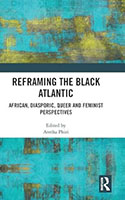 Commemorating the thirtieth anniversary of Paul Gilroy's seminal text, The Black Atlantic: Modernity and Double Consciousness, this book offers fresh interpretations of established black Atlantic scholarship from the perspective of those typically elided from its ideological purview and existential narrative. The application of queer and/or feminist lenses in each essay attempts to mediate these elisions and to advance potentially transformative, democratising readings of the black Atlantic from both complex and complicating African and diasporic viewpoints. With the aim of realigning black Atlantic scholarship in this way, the edited volume proposes an interventionist approach that is concerned with problematizing ethnic/ cultural universalisms and challenging geographic and gendered hierarchizations. Underlining the importance of aesthetic and creative cultural archives, Reframing the Black Atlantic's focus on transnational African diasporic literature and other intersecting popular cultural forms probes the (imaginative) limits and possibilities of the black Atlantic, conventionally conceived. To this end, this book intends not just to complicate and enhance established views of black Africa; inviting the reader to locate and perceive black life lived otherwise, it points towards more inclusive and expansive global understandings and visions of blackness.
Commemorating the thirtieth anniversary of Paul Gilroy's seminal text, The Black Atlantic: Modernity and Double Consciousness, this book offers fresh interpretations of established black Atlantic scholarship from the perspective of those typically elided from its ideological purview and existential narrative. The application of queer and/or feminist lenses in each essay attempts to mediate these elisions and to advance potentially transformative, democratising readings of the black Atlantic from both complex and complicating African and diasporic viewpoints. With the aim of realigning black Atlantic scholarship in this way, the edited volume proposes an interventionist approach that is concerned with problematizing ethnic/ cultural universalisms and challenging geographic and gendered hierarchizations. Underlining the importance of aesthetic and creative cultural archives, Reframing the Black Atlantic's focus on transnational African diasporic literature and other intersecting popular cultural forms probes the (imaginative) limits and possibilities of the black Atlantic, conventionally conceived. To this end, this book intends not just to complicate and enhance established views of black Africa; inviting the reader to locate and perceive black life lived otherwise, it points towards more inclusive and expansive global understandings and visions of blackness.
This volume will be of particular use to researchers and students in the fields of race/gender, diaspora/transnational, literary and cultural studies. The chapters of this book were originally published in Cultural Studies.
[Return to table of contents]
New Book
A Southern Underground Railroad:
Black Georgians and the Promise of Spanish Florida and Indian Country
By Paul M. Pressly
University of Georgia Press
324 pp., ISBN-13 978-0820366852, 2024.
Description from the Publisher:
 Despite its apparent isolation as an older region of the country, the Southeast provided a vital connecting link between the Black self-emancipation that occurred during the American Revolution and the growth of the Underground Railroad in the final years of the antebellum period. From the beginning of the revolutionary war to the eve of the First Seminole War in 1817, hundreds and eventually several thousand Africans and African Americans in Georgia, and to a lesser extent South Carolina, crossed the borders and boundaries that separated the Lowcountry from the British and Spanish in coastal Florida and from the Seminole and Creek people in the vast interior of the Southeast. Even in times of peace, there remained a steady flow of individuals moving south and southwest, reflecting the aspirations of a captive people.
Despite its apparent isolation as an older region of the country, the Southeast provided a vital connecting link between the Black self-emancipation that occurred during the American Revolution and the growth of the Underground Railroad in the final years of the antebellum period. From the beginning of the revolutionary war to the eve of the First Seminole War in 1817, hundreds and eventually several thousand Africans and African Americans in Georgia, and to a lesser extent South Carolina, crossed the borders and boundaries that separated the Lowcountry from the British and Spanish in coastal Florida and from the Seminole and Creek people in the vast interior of the Southeast. Even in times of peace, there remained a steady flow of individuals moving south and southwest, reflecting the aspirations of a captive people.
A Southern Underground Railroad constitutes a powerful counter-narrative in American history, a tale of how enslaved men and women found freedom and human dignity not in Jefferson's “Empire of Liberty” but outside the expanding boundaries of the United States. It is a potent reminder of the strength of Black resistance in the post-revolutionary South and the ability of this community to influence the balance of power in a contested region. Paul M. Pressly's research shows that their movement across borders was an integral part of the sustained struggle for dominance in the Southeast not only among the Great Powers but also among the many different racial, ethnic, and religious groups that inhabited the region and contended for control.
[Return to table of contents]
Book Review
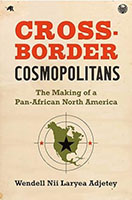
Wendell Nii Laryea Adjetey. Cross-Border Cosmopolitans: The Making of a Pan-African North America. Chapel Hill: University of North Carolina Press, 2023. xviii + 400 pp. (paper), ISBN 978-1-4696-7211-3.
H-Net Book Review, published by H-Caribbean, https://networks.h-net.org/h-caribbean (August, 2024).
Reviewed for H-Caribbean by Nicholas Grant (University of East Anglia).
Lascelles "Peabody" Small traveled the world from the deck of a cargo ship. Born in Jamaica, he first arrived in the United States as a crew member on a freighter transporting bauxite and iron ore to Mobile, Alabama, where, upon disembarkation, he was immediately confronted by the stark realities of Jim Crow. The same ship then left the Gulf of Mexico, traveling up the Eastern Seaboard and docking in Baltimore, Maryland, before heading to Montreal, Canada. Between 1958 and 1960, Small was based in Brooklyn, New York, as a resident of Norwegian Seaman's House, where he experienced life in the "Jim Crow North" while also working on ships that traversed the Atlantic. In the 1960s, he decided to move North again and applied for permanent residency in Canada.
The life and travails of Small, beautifully recovered and rendered in Wendell Nii Laryea Adjetey's Cross-Border Cosmopolitans: The Making of a Pan-African North America, provide a glimpse into the interconnected racial histories of the Caribbean, the United States, and Canada. This innovative book examines the transnational lives of people of African descent who navigated the interrelated racisms of each of these regions. It asks, "How do we explain a people whose migrations, labor, family ties, social aspirations, politics, and revolutionary struggle transcended the boundaries of empires and states?" In response, Adjetey adopts a hemispheric lens that traces the lives and Pan-African visions of politicians, activists, workers, artists, and state agents throughout North America. He shows how "African North Americans" worked to find home in diaspora "by imagining and forging diasporic and transnational communities that spanned the United States, Canada, the Caribbean basin, and Africa" (p. 2). Emphasizing the fluidity of borders and the mobility of people of African descent, Cross-Border Cosmopolitans details how border crossing "amplified Pan- Africanisms" that facilitated Black claims for citizenship and self-determination. As Adjetey argues, in this context, "Black liberation -- whether moderate or revolutionary -- was intergenerational, international, and intercontinental" (p. 9).
One of the major strengths of this study is how the author takes the reader from the early 1900s to the mid-1980s, expertly detailing the connections between political movements and specific activists. The book opens with the emergence of the New Negro movement and "the messianic moment" of Garveyism, contributing to recent scholarly works on the global contours of Garveyism by documenting the impact the United Negro Improvement Association (UNIA) had in Canada.[1] In total, there were thirty UNIA branches in the country, while Garveyites also worked with such organizations as the Canadian League for the Advancement of Colored People to challenge white conceptions of nationhood. Adjetey's insistence on the power of cross-border cooperation between people of African descent in North America is most clearly illustrated through his expert analysis of the Canadian newspaper Dawn of Tomorrow, published in London, Ontario, by James Francis Jenkins, a protégé of W. E. B Du Bois, and its editorials on race relations. Dawn of Tomorrow's origins, production, and focus clearly illustrate the hemispheric dimensions of "race first" militancy.
Chapter 2 then moves to the development of Pan-African politics from the 1930s to the 1950s, again emphasizing the importance of Black mobility and migration across state borders. Adjetey notes how the process of "self-exile" sometimes "mitigated ... the potency of anti-Black racism" by allowing migrants to maintain familial and social ties as well as important political strategies (p. 67). Focusing largely on the Great Lakes cities, the chapter makes clear the close policing of borders, reminding the reader of the need to resist the notion that Canada somehow represents a racially enlightened counterpoint to the United States. Adjetey's concept of "citizenship passing" is especially intriguing in this chapter. Speaking to how "migrants exchanged one identity for an alternative one, sometimes discarding a former identity but always melding aspects of belonging to personal advantage," he provides scholars and activists with another way of thinking about the malleable and multilayered meaning of citizenship, as well as the political agency of Black people on the move (p. 70).
The book then moves to the early Cold War and the age of decolonization, documenting how concepts of civil and human rights were constructed across borders. This fascinating chapter is based around the life and career of Daniel Grafton Hill. Born and raised in the US, Hill graduated from Howard University and served in the army during World War II. In the aftermath of the war, he moved to Canada and in 1950 began his graduate studies at the University of Toronto, later earning a PhD in sociology. Hill's role as the director of Ontario's Human Rights Commission, where he launched an ambitious new race relations program, is covered in detail. As a liberal figure, Hill is somewhat of an outlier in terms of the cast of radical leftists who are more often at the heart of the book. However, his inclusion as a cross-border cosmopolitan "who could advance Black solidarity discretely" clearly illustrates the political diversity and complexity of Black international thought, especially as Black activists and politics navigated the repressive politics of anticommunism (p. 146).
In chapter 4 we are introduced to two central characters who feature regularly in the second half of the book: Anne Cools and Rosie Douglas, young Black radicals who would both later assume elected office. Their activism demonstrates how the global politics of Black Power fused with the anti-war movement to transform debates about race and rights in Canada.[2] To emphasize this point, Adjetey calls our attention to lesserknown activists, such as African Nova Scotian Burnley "Rocky" Jones of the Black United Front. Widely referred to as "Canada's Own Stokely Carmichael," Jones told a crowd at the University of Toronto in 1968, "If you don't get up off me I am going to throw you off and I'm going to stomp you. Whatever you do to us, we will do to you" (pp. 171, 175). The transnational politics of Black radicalism are also the focus of the book's next chapter, which moves to the issues of state repression and specifically collaboration between the Federal Bureau of Investigation (FBI) and the Royal Canadian Mounted Police. The scale and audaciousness of the counterinsurgency efforts of FBI operative Warren Hart are staggering and once again make clear the lengths to which the state went to curtail Black organizing in the 1960s and 1970s. The final chapter of Cross-Border Cosmopolitans expertly weaves together how US-Canadian businesses circumvented the arms embargo against apartheid South Africa, while also highlighting the role played by US and Canadian white power paramilitaries in orchestrating attempted coups in Grenada and Dominica. As Adjetey notes, when considering the evidence outlined in his last two chapters, "It becomes difficult to disentangle nonstate actors, such as the Ku Klux Klan and neo-Nazi mercenaries, from the US government and its intelligence agencies" (p. 259).
A particularly impressive feature of Cross-Border Cosmopolitans is the author's mining of a range of archival sources, coupled with nuanced close readings of this material. State archives, declassified intelligence reports, organizational and personal papers, oral interviews, and newspaper records are considered together to map these Black international histories from the "top down" and the "bottom up," with the book nicely emphasizing the mobility and cosmopolitanism of working-class African North Americans, as well as more prominent political leaders and officials. Adjetey's use of "Pan-Africanisms" (in the plural) does justice to the multifaceted and diverse webs of solidarity that shaped Black responses to empire, colonialism, and white supremacy. Again, his insistence that Pan-Africanisms are "dynamic and contested endeavours that evolved generationally" maps the complexity of the global engagements of people of African descent while illustrating how Black activists were constantly in dialogue with their forbears as they worked to "retake power from their subjugators, and create selfsufficient, independent homes and communities, small and large, local and global" (p. 7).
Yet Adjetey's initial framing does carry the slight danger of reifying and elevating the experiences and actions of African North Americans in terms of the broader history of Pan-Africanism and Black internationalism. While Cross-Border Cosmopolitans does important work when it comes to "de-exceptionalizing U.S. history" and questioning dominant narratives in relation to Black protest by tracing how African Americans engaged in anti-racist politics at a hemispheric level, this emphasis occasionally slips into elevating the contributions of North Americans to Pan- African politics over others (p. 17). As Adjetey states, "The impetus of twentieth-century global Black liberation ... emerged out of African North America" (p. 18). It is important to fully recognize the scale and militancy of Black organizing in this region throughout the twentieth century; however, this claim might give the impression that ideas and actions emanating from Africa and other parts of the Black diaspora were ultimately less important. As such scholars as Laura Chrisman, Annette K. Joseph-Gabriel, Minkah Makalani, and Patricia de Santana Pinho have pointed out, there is still work to do to correct the imbalance that has seen North American voices privileged in historical accounts of Black internationalism.[3] Indeed, Kira Thurman puts this nicely in a recent roundtable in the American Historical Review by asking, "How much is Black internationalism indebted to a particularly (African) American sensibility, even while it works to disavow nationalist hegemonies?"[4]
There are also tantalizing moments throughout Cross-Border Cosmopolitans where the struggles of Indigenous peoples intersect with Black activism. For example, Daniel G. Hill's work on Native rights in the northern Ontarian town of Kenora and the connections between Black Power and Red Power in the late 1960s represent important moments in the book. While it is perhaps beyond the scope of this study -- which already packs a huge amount historically and conceptually -- I was left wanting more about the moments of confluence, or indeed tensions, that animated the transnational histories of Black and Indigenous peoples in North America.[5]
These points should not detract from what is a remarkable scholarly achievement. Adjetey has made an important contribution to the field of diaspora studies, one that will force scholars to rethink the geography of Black internationalism in North America for years to come. Furthermore, the political geographies and relationships recounted in this impressively crafted book make clear how activists practically challenged racism and imperialism on different scales—locally, nationally, and globally. There is a lot that Cross-Border Cosmopolitans can teach contemporary activists in this regard. As Adjetey notes, "Language has the power to forecast revolution" (p. 59).
Notes
[1]. For key studies on the global politics of Garveyism, see Adam Ewing, The Age of Garvey: How a Jamaican Activist Created a Mass Movement and Changed Global Black Politics (Princeton, NJ: Princeton University Press, 2014); Frank Guridy, "Making New Negroes in Cuba: Garveyism as a Transcultural Movement," in Escape from New York: The New Negro Renaissance beyond Harlem, ed. Davarian L. Baldwin and Minkah Makalani (Minneapolis: University of Minnesota Press, 2013); Erik S. McDuffie, "Chicago, Garveyism, and the History of the Diasporic Midwest," African and Black Diaspora: An International Journal 8, no. 2 (2015): 129-45; Ronald J. Stephens and Adam Ewing, eds., Global Garveyism (Gainesville: University Press of Florida, 2019); and Robert Trent Vinson, "‘Sea Kaffirs': ‘American Negroes' and the Gospel of Garveyism in Early Twentieth-Century Cape Town," Journal of African History 47, no. 2 (2006): 281-303.
[2]. For important work on the global dimensions of Black Power, see Ashley D. Farmer, Remaking Black Power: How Black Women Transformed an Era (Chapel Hill: University of North Carolina Press, 2017); Michael R. Fischbach, Black Power and Palestine (Stanford, CA: Stanford University Press, 2018); Tanisha Ford, Liberated Threads: Black Women, Style, and the Global Politics of Soul (Chapel Hill: University of North Carolina Press, 2015); Alex Lubin, Geographies of Liberation: The Making of an Afro-Arab Political Imaginary (Chapel Hill: University of North Carolina Press, 2014); Sean L. Malloy, Out of Oakland: Black Panther Party Internationalism during the Cold War (Ithaca, NY: Cornell University Press, 2017); Brenda Gayle Plummer, In Search of Power: African Americans in the Era of Decolonization, 1956-1974 (Cambridge: Cambridge University Press, 2012); and Nico Slate, ed., Black Power beyond Borders: The Global Dimensions of the Black Power Movement (New York: Palgrave Macmillan, 2012).
[3]. Laura Chrisman, "Rethinking Black Atlanticism," Black Scholar 30, nos. 3-4 (2000): 14-16; Laura Chrisman, Postcolonial Contraventions: Cultural Readings of Race, Imperialism and Transnationalism (Manchester: Manchester University Press, 2003): 90-91; Annette K. Joseph-Gabriel, Reimagining Liberation: How Black Women Transformed Citizenship in the French Empire (Urbana: University of Illinois Press, 2019); Minkah Makalani, In the Cause of Freedom: Radical Black Internationalism from Harlem to London, 1917-1939 (Chapel Hill: University of North Carolina Press, 2011), esp. introduction; and Patricia de Santana Pinho, "Decentering the United States in the Studies of Blackness in Brazil," Revista Brasileira de Ciências Sociais 20, no. 59 (2006): 37-50.
[4]. Monique Bedasse et al., "AHR Conversation: Black Internationalism," American Historical Review 125, no. 5 (2020): 1704.
[5]. Here I am thinking of US-focused work by Kyle T. Mays, An Afro-Indigenous History of the United States (Boston: Beacon Press, 2021); and Tiya Miles, "Uncle Tom Was an Indian: Tracing the Red in Black Slavery," in Relational Formations of Race: Theory, Method, and Practice, ed. Natalia Molina (Berkeley: University of California Press, 2019), 124.
[Citation: Nicholas Grant. Review of Adjetey, Wendell Nii Laryea, Cross-Border Cosmopolitans: The Making of a Pan-African North America. H-Caribbean, H-Net Reviews. August, 2024. This work is licensed under a Creative Commons Attribution-Noncommercial-No Derivative Works 3.0 United States License. H-Net permits the redistribution and reprinting of this work for nonprofit, educational purposes.]
[Return to table of contents]
Book Review
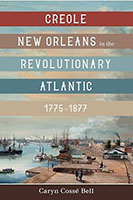
Caryn Cossé Bell. Creole New Orleans in the Revolutionary Atlantic, 1775–1877. Baton Rouge: Louisiana State University Press, 2023. xi + 325 pp. (cloth), ISBN
978-0-8071-7937-6.
H-Net Book Review, published by H-Caribbean, https://networks.h-net.org/h-caribbean (July, 2024).
Reviewed for H-Caribbean by Samuel Biagetti (Historiansplaining Podcast).
New Orleans has long presented an awkward problem for American historians. Sited to control the gateways between the Gulf of Mexico and the Mississippi basin, it has been a strategic fulcrum of war, commerce, and politics in southeastern North America since the eighteenth century. In the antebellum age, it was the largest city south of Baltimore, a rising industrial port, the great nerve center of the cotton traffic, and the hub of the internal slave trade; in the Confederacy, it dwarfed the next largest city by more than four to one. Yet far from typifying the region as customarily understood, New Orleans stands out in the southern landscape as a predominantly Catholic city, in which languages, laws, and customs deriving from the city's French founding allowed for the emergence of a large and sometimes prosperous free population of color and for a degree of social intermingling across what was, in most of Anglo- America, a rigid color line.
American popular history usually resolves the New Orleanian paradox by trivializing the city's Francophone and Creole heritage as the romantic (or even morbid) vestiges of a declining Old World culture, fated to be swept away by the Civil War and the march of modernity. The tragic view of the Creole city had its roots partly in the 1880s writings of George Washington Cable, which combined a degree of realism with Anglo-Protestant condescension. It was captured most fully in the 1930s play and film Jezebel, which cast the catastrophic yellow fever epidemic of 1853 as a harbinger of doom for a decadent and corrupt society. Meanwhile, scholarly histories of the American South tend to gloss over or ignore the New Orleanian paradox. For instance, studies of the Civil War and Reconstruction usually treat Louisiana as typical of the Deep South, set apart only by the unusual length of Reconstruction in the state (from occupation in 1862 until the withdrawal of federal troops following the compromise of 1877) and by its degree of violence and tumult, instantiated in the 1866 New Orleans massacre.
The central question facing recent scholars of colonial and nineteenth-century New Orleans, then, has tended to be whether the city's French Catholic background should be understood to set it apart in a politically significant and impactful way from the rest of the American South or merely to provide quaint local color to what was otherwise a typical North American slave society. The debate has been haunted by the notorious "Tannenbaum thesis" -- named for sociologist Frank Tannenbaum, who argued that French and Iberian colonial societies established looser laws and norms around race than their northern European counterparts. Support for such an interpretation of New Orleans seemed to emerge from studies of the French and Spanish colonial records, most significantly, Gwendolyn Midlo Hall's 1992 Africans in Colonial Louisiana: The Development of Afro-Creole Culture in the Eighteenth-Century, which argues that the weakness of the French regime and its comparatively loose laws and customs defining slavery allowed for autonomy and strong social bonds among Africans and Afro-Creoles, giving rise, in turn, to political resistance, such as the attempted Bambara uprising of 1731. Hall's argument offers to cast a new light on subsequent events in Louisiana, including such upheavals as the 1811 German Coast slave rebellion, the largest in American history.
Later works sought to counter the emergence of what one might call the new Louisiana exceptionalism— and more fundamentally, the romantic image of New Orleans as a free-wheeling French outpost. Thomas N. Ingersoll, in Mammon and Manon in Early New Orleans: The First Slave Society in the Deep South, 1718-1819 (1999), argues that irrespective of events in the outer parishes, colonial New Orleans was a rigid society based on slavery and racial repression, fundamentally similar to such Anglo-American slave societies as South Carolina—hence its easy and swift integration into the United States. Ingersoll's book has been followed in more recent years by studies emphasizing the centrality of slavery and racism to early New Orleans, such as Rashuana Johnson's Slavery's Metropolis: Unfree Labor in New Orleans during the Age of Revolutions (2016) and Cécile Vidal's Caribbean New Orleans: Empire, Race, and the Making of a Slave Society (2019).
Caryn Cossé Bell's latest book may constitute the most important intervention in this debate since the 1990s. Bell presents a novel and powerful case for New Orleans's distinctiveness in the American landscape while largely ignoring Louisiana's French and Spanish colonial history. Bell's book stresses instead the large migration into New Orleans of refugees from Saint Domingue that followed the Haitian Revolution and culminated in the 1809-10 wave that doubled the size of the city. Bell argues that the multiracial influx from the Caribbean brought with it dense interracial networks of kinship and politics, bolstered the city's Francophone Catholic population, and fortified its French-style social and legal systems, just in time to withstand the onslaught of hostile Anglophone migrants. She points out, for instance, that Louis Moreau-Lislet, the jurist who wrote Louisiana's civil law code of 1808 and delivered the court ruling that enshrined mixed-race citizens' right to a presumption of freedom, was an 1804 migrant from Haiti.
More importantly, Bell's argument largely avoids reliance on French essentialism, sidestepping the quagmire of the Tannenbaum debate in favor of an effort to link New Orleans politics to the legacy of the Age of Revolutions. "Nowhere else in the United States," Bell concludes, "did the French and Haitian Revolutions exert as enduring an influence as in New Orleans and south Louisiana" (p. 231). In support, the book presents a cavalcade of statements and actions by New Orleanians of all colors who trumpeted the ideals "Liberty, Equality, and Fraternity" and doggedly carried the banner of the revolutionary era all the way through the nineteenth century.
Drawing on sources from the New Orleans press, as well as memoirs, correspondence, and biographical dictionaries, the book strings together an astonishing array of incidents that shocked Anglo-American observers at the time, just as they may modern-day readers who imagine New Orleans to be an ordinary antebellum city: large companies of Black men bearing arms in the state militia and serving under Andrew Jackson's command, before volunteering to fight in support of the revolutionary republican government of Mexico and securing for it a crucial foothold in Texas; Creole ladies of various colors worshiping together, circulating radical French Romantic tracts, opening interracial schools for girls, and attempting to found an interracial convent; Spiritualists holding séances to communicate with the dead and taking the spirit world as a template for the free and equal republic that ought to exist on earth; fraternal societies embracing republican ideals and calling for "the acquisition of rights which assure the liberty of man in every country" (p. 162); large gatherings celebrating the 1848 revolution in France, marching through the city singing the "Marseillaise," and holding memorials for fallen revolutionaries in the Cathedral of St. Louis; legislators electing to the US Senate a French republican dissident who had fled to New Orleans to escape arrest by Charles X's regime; a missionary priest openly preaching against slavery in the city's cathedral as late as 1850.
Although sometimes meandering and disjointed, Bell's book uncovers a continuing thread of experimentation, opposition, and radical hope that crossed boundaries of time and space. The dissident milieu linked New Orleans to the French-speaking world, with many reformist scholars and doctors, including men of color, studying in Paris and imbibing the heady ideas of the Revolution and the Romantic age. Ironically, whereas Jezebel casts the 1853 yellow fever outbreak as a symbol of New Orleans's descent into decadence, in Bell's book it serves as an arena for Parisian-educated physicians of color to debunk the racist myths of so-called states-rights medicine and to demonstrate revolutionary new techniques of diagnosis and public health.
Moreover, Bell's narrative effectively links New Orleans's Creole heritage with the events of the Civil War and Reconstruction. General Benjamin Butler's enlistment of Black New Orleanians into the Union army under the command of Black officers in 1862 (the first such action in the Civil War) is unsurprising in light of the long precedent of Black men in New Orleans -- including most of those who enlisted under Butler -- having served in uniform. Butler's occupation regime and the subsequent Reconstruction governments went far beyond the southern norm by desegregating public transit, schools, and all places of public accommodation; under universal male suffrage, Louisiana voters elected Black officials to more statewide executive offices than in any other state. Even as armed white mobs and paramilitary groups from 1866 to 1877 attacked the state government in a series of riots and insurrections, interracial coalitions attempted to maintain stability: in 1873, the "Unifier" movement proposed to maintain equal civil rights while dividing state offices evenly between whites and Blacks, and whereas the program gained traction in New Orleans, it failed in the rural parishes. Ultimately, as racist violence undid interracial democracy after 1877, Afro-Creoles sought to secure their rights through a long campaign in the courts, culminating in the Plessy decision of 1896, in which the Supreme Court rejected a New Orleans Creole man's suit against transit segregation. Whereas the ruling, which placed the court's imprimatur on segregation, has customarily been seen as the start of the age of Jim Crow, in Bell's story, it appears as a last stand by Afro-Creole New Orleans against the Anglo-American racial order.
Ultimately, Bell's narrative serves to challenge the conventional periodization of American and Atlantic history. Whereas, from the Anglo-American perspective, a long gap intervenes between the revolutionary period and the Civil War, Creole New Orleans, with its continuing links to the Caribbean, Latin America, and France, saw no such interruption; the upheavals of the Civil War and emancipation could be seen by many as the fulfillment of a continuing revolutionary quest. Throughout the war and Reconstruction period, the New Orleans Francophone press championed radical reforms, such as the breakup and redistribution of large estates in language recalling the revolutionary movements of Europe and the Americas. The premiere bilingual newspaper, the Tribune, which served for a time as the official outlet of the Reconstruction regime, was edited by Jean-Charles Houzeau, a Belgian astronomer and dissident who had fled to America after 1848.
Nonetheless, the impact of Creole New Orleans is likely to be blunted somewhat by problems of organization and interpretation. Bell takes some time to circle in toward her main theses, which are stated more clearly in the conclusion than in the introduction. The latter proposes rather broadly to fulfill the need for "an overall study" of "the city's history in the revolutionary age" but gives the reader fairly little guidance as to how to assign significance to the mass of evidence in the book, which becomes overwhelming -- in the negative as well as positive sense of the word (p. 2). The book comprises three sections: on the Haitian Revolution and migration to Louisiana, the Romantic movement, and the Civil War and Reconstruction. In the book's first and third sections, the narrative meanders and leaps among a wide array of characters, who enter the stage with dizzying rapidity only to exit again, too soon in many cases to gain a sense of their distinct personalities or their significance. The experience of reading becomes taxing in the absence of clear explanations as to how this prosopographic phantasmagoria relates to Bell's larger argument.
Moreover, Bell's introduction forecasts that the book will use as its "backbone" the memoir, published in 1883, of the Creole writer Hélène d'Aquin Allain, who grew up mainly in antebellum New Orleans (p. 2). However, Allain's Souvenirs is only alluded to in the entire first section of Creole New Orleans and is discussed extensively only in the book's second section, dealing with the Romantic movement. This section stands out dramatically from the other two, drawing on the essays, books, and diaries that emerged from a vibrant bilingual intellectual scene, composed mainly of women, which promoted the new mystical, egalitarian, and humanitarian strains of French Catholicism in mid-century New Orleans. Only this section brings to life the social and emotional lives of some of its characters, often through remarkably vivid scenes, for example, a maiden aunt's austere attic room in which she spent her days in prayer and reflection before finally joining a convent and a Congolese-born bride's tignon (turban) tied off in knots in the shape of cowrie shells to recall her African birth. This second section might easily be expanded into a book of its own. In this context, it seems slightly cramped in ways that also typify the book as a whole, such as in its curious lack of visuals, even as the text discusses visual evidence like portraiture.
More crucially, the link between this middle section and the other two is tenuous and underdeveloped. Although the ideas and arguments that antebellum Creole women promoted clearly have political import, Bell presents them uncritically as "revolutionary" and "emancipatory." Her interpretation elides distinctions among several different currents of thought -- for example, republicanism, abolitionism, humanitarianism, Romanticism, mysticism, and the traditional French three-tiered system of race -- which did not always align and sometimes came into conflict. Thus, Bell overlooks important nuances and contradictions in her subjects' worldviews. For instance, Bell quotes Allain, in defending the reputation of the New Orleans Creole community against slander, asserting that in her uncle's household, "masters and servants were part of a truly Christian family" and that Creole chroniclers should emphasize "the role played by these good masters" (p. 100). Such a passage might have prompted a commentary on how Christian and Romantic humanitarianism could be folded into an apology for slavery. The lack of such an ideological analysis is driven home a few lines later when Allain is quoted as asserting that many Louisiana planters espoused the rights of man and "were ready to make any sacrifice to reconcile their lawful interests with their humanitarianism" (p. 100). One might reasonably ask whether these planters' commitment to their humanitarian ideals actually extended to sacrificing their right to own slaves. Similarly, when another apologist, Éléonore Ligeret de Chazey, pleads that Louisiana slave mistresses, though "unable to stop slavery ... soften it with all their might," it is left to the reader to consider how Creole humanitarian rhetoric might have fit into the wider stream of ameliorationism (p. 147). In this light, Creole New Orleans might appear less as a radical hotbed than as a place, like Maryland in Barbara J. Fields's study, Slavery and Freedom on the Middle Ground: Maryland during the Nineteenth Century (1985), where eighteenth-century muddled thinking about slavery was able to persist into the antebellum age.
Such a superficial and uncritical interpretation presents less of a problem in the book's first and third sections, which draw on political tracts and slogans with far less ambiguous rhetoric. Nonetheless, these sections might have been more powerful with the support of quantitative evidence, such as census numbers and election results, which could have helped to map out the political factions of the city and could have conveyed a more precise sense of how large and prevalent the radical wing actually was. Finally, Bell's argument would have been strengthened by a consideration of class stratification in New Orleans, including within the Afro-Creole community, to show how tangible class interests could reinforce and sustain revolutionary ideals.
In sum, Creole New Orleans in the Revolutionary Atlantic can be seen to contain within itself two different books -- one dealing with the mostly male-dominated world of revolutionary politics and the other with the mainly female world of Romantic philosophical ferment -- which never entirely meld together. Each side of Bell's work has its own strengths and weaknesses, and each one might have been strengthened with more critical interpretation, such as to make a complete and powerful book in its own right.
Nonetheless, the book that exists should hopefully have a deep impact, effectively demolishing any notion of New Orleans as fitting easily or unproblematically into the nineteenth-century South. Bell's research pays tribute to the imagination and the persistence of radicals of various stripes that made New Orleans a laboratory of revolutionary vision in the nineteenth century. As I have noted in my own work, there is a great irony in the fact that when the US Congress, in the 1810s, debated the possibility of Louisiana joining the Union, many Anglo-Americans warned that the Catholic Creoles would be unable to assimilate to a democratic-republican government -- conveniently ignoring the long history of rebellion and republican ferment on the lower Mississippi, even predating the American Revolution. Bell's book, irrespective of its flaws, should help put to bed this form of Anglo-American condescension and promote in its place an appreciation for the revolutionary spirit that has long thrived in New Orleans.
[Citation: Samuel Biagetti. Review of Bell, Caryn Cossé, Creole New Orleans in the Revolutionary Atlantic, 1775–1877. H-Caribbean, H-Net Reviews. July, 2024. This work is licensed under a Creative Commons Attribution-Noncommercial-No Derivative Works 3.0 United States License. H-Net permits the redistribution and reprinting of this work for nonprofit, educational purposes.]
[Return to table of contents]

©2024 African Diaspora Archaeology Network
Copyright and all rights reserved by
individual authors for each article.
Please send comments, suggestions,
or questions to the editor
Last updated: September 29, 2024
Text only menuSearch
|



